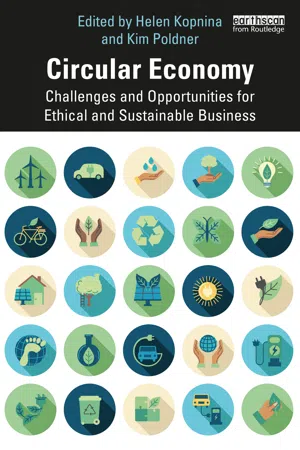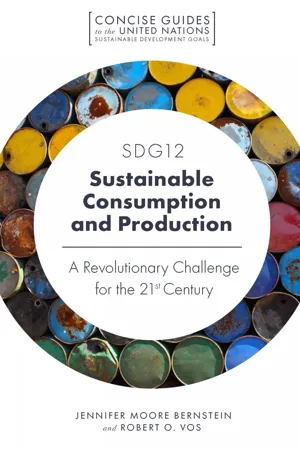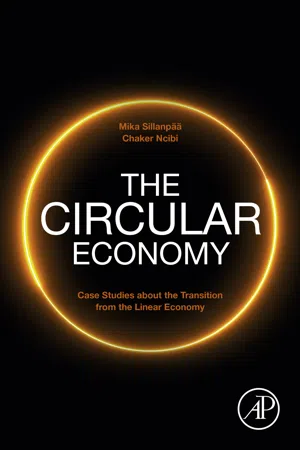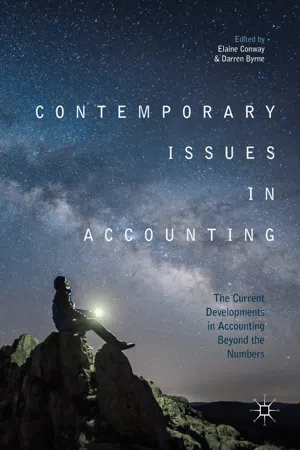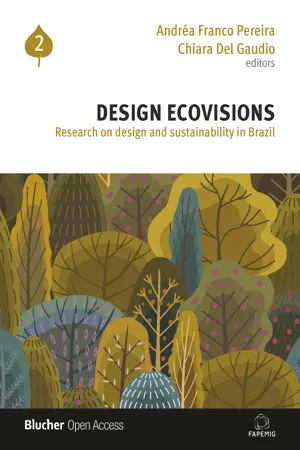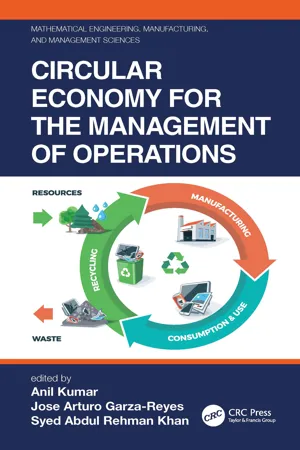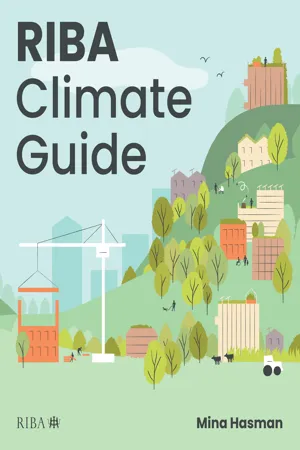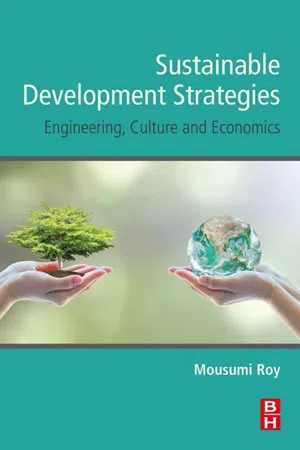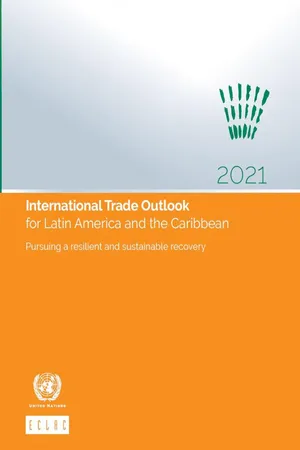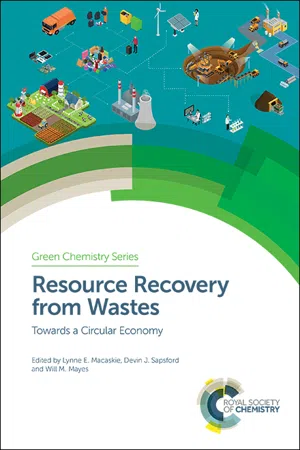Geography
Circular Economy
The circular economy is an economic system aimed at minimizing waste and making the most of resources. It focuses on designing products that can be reused, repaired, and recycled, as well as promoting sustainable consumption and production practices. The goal is to create a closed-loop system where materials and products are kept in use for as long as possible.
Written by Perlego with AI-assistance
Related key terms
1 of 5
12 Key excerpts on "Circular Economy"
- eBook - ePub
Circular Economy
Challenges and Opportunities for Ethical and Sustainable Business
- Helen Kopnina, Kim Poldner, Helen Kopnina, Kim Poldner(Authors)
- 2021(Publication Date)
- Routledge(Publisher)
IntroductionChallenges and opportunities of the Circular Economy
Helen Kopnina and Kim PoldnerSpaceman versus cowboy economy
One of the greatest challenges of sustainability is addressing the continuous production and consumption of natural resources that result in depletion, pollution, climate change and biodiversity loss. The Circular Economy (CE) concept is seen by many as a novel pathway to sustainability. The CE can be viewed as a concept, a framework and a process with its main goal being to provide an alternative for the traditional take-make-waste systems (Bocken et al., 2017; Kirchherr & Piscicelli, 2019). The key development in the area of sustainable production and consumption is that it seeks to limit or even, ideally, stop the continuous extraction of natural resources. Basically, the concept of circularity entails reducing if not completely eliminating the consumption of new (raw) materials and designing products in such a manner that they can easily be taken apart and reused after use. In a circular system, prolonging the lifespan of products can be done through reuse, maintenance, repair and recovery of raw materials from waste flows (Kirchherr & Piscicelli, 2019). The concept of circularity also implies the intention to keep materials that the products are made of at their highest utility and value all the time (Bocken et al., 2017). The CE advocates for biomimicry and bioeconomy, ecosystem service valuation and renewable energy (Buchmann-Duck & Beazley, 2020).One of the CE’s inspirations is the cradle-to-cradle (C2C) framework. The C2C framework is based on the book Cradle to Cradle: Remaking the Way We Make Things by Michael Braungart and William McDonough first published in 2002, developing the concept of circularity of material flows, both in nature and in production. As the authors argue, the current system of ‘cradle-to-grave’ production supports management practices that focus on economic benefits through endless take-make-waste cycles. These can include products designed in such a way that consumers will need to keep buying them because they’re actually designed not - eBook - PDF
SDG12 - Sustainable Consumption and Production
A Revolutionary Challenge for the 21st Century
- Jennifer Moore Bernstein, Robert O. Vos(Authors)
- 2021(Publication Date)
- Emerald Publishing Limited(Publisher)
The goal here is to identify new opportunities for value-added production in existing or new economic sectors and prioritize subsidies and policies to sup-port such enterprises. After reviewing many empirical studies and concept papers that offer varying definitions of CE, Kirchherr et al. (2017) synthesized the following definition: A Circular Economy describes an economic system that is based on business models which replace the “end-of-life” concept with reducing, alternatively reusing, recycling and recovering materials in production/distribution and consumption processes, thus operating at the micro level (products, companies, consumers), meso level (eco-industrial parks) and macro level (city, region, nation and beyond), with the aim to accomplish sustainable development, which implies creating environmental quality, economic prosperity and social equity, to the benefit of current and future generations. (pp. 224–225) We embrace this definition for at least two reasons. First, it is all-encompassing enough to assess the degree to which SDG12 is informed by and aligns with emerging work on circular economies. Second, it carefully articulates different and overlapping spatial scales for the operation and govern-ance of CE. As we argue below, higher levels of circularity are blocked by discoordination among policies ranging from product manufacturing to the local and global levels that control regulations and waste infrastructure. Thus, better governance of CE means coordinating designs improvements for products and packaging with collection, sorting, and 76 SDG12 - Sustainable Consumption and Production processing systems, including the modification of trade policies as appropriate. CE IN INDUSTRIAL ECOLOGY Industrial ecology is a multidisciplinary field that measures the interaction of human systems, especially technological systems, with the natural world. - eBook - ePub
The Circular Economy
Case Studies about the Transition from the Linear Economy
- Mika Sillanpaa, Chaker Ncibi, Mika Silanpää, Mika Sillanpää(Authors)
- 2019(Publication Date)
- Academic Press(Publisher)
Circular Economy is an economy constructed from societal production-consumption systems that maximizes the service produced from the linear nature-society-nature material and energy throughput flow. This is done by using cyclical materials flows, renewable energy sources and cascading1-type energy flows. Successful Circular Economy contributes to all the three dimensions of sustainable development. Circular Economy limits the throughput flow to a level that nature tolerates and utilises ecosystem cycles in economic cycles by respecting their natural reproduction rates.”- - According to the Dutch Council for the Environment and Infrastructure, an independent strategic advisory board for the government and parliament on sustainable development issues, CE “
stresses the following focal points: reducing the consumption of raw materials, designing products in such a manner that they can easily be taken apart and reused after use (eco-design), prolonging the lifespan of products through maintenance and repair, and the use of recyclables in products and recovering raw materials from waste flows. A Circular Economy aims for the creation of economic value (the economic value of materials or products increases), the creation of social value (minimization of social value destruction throughout the entire system, such as the prevention of unhealthy working conditions in the extraction of raw materials and reuse) as well as value creation in terms of the environment (resilience of natural resources)” [52] .- - UK researchers and scientists from different business schools suggested a definition which reads: “
The Circular Economy is an economic model wherein planning, resourcing, procurement, production and reprocessing are designed and managed, as both process and output, to maximize ecosystem functioning and human well-being”[8] .- - Other scientists from manufacturing and industrial design backgrounds defined CE as “
a regenerative system in which resource input and waste, emission, and energy leakage are minimised by slowing, closing, and narrowing material and energy loops. This can be achieved through long-lasting design, maintenance, repair, reuse, remanufacturing, refurbishing, and recycling - eBook - ePub
Contemporary Issues in Accounting
The Current Developments in Accounting Beyond the Numbers
- Elaine Conway, Darren Byrne, Elaine Conway, Darren Byrne(Authors)
- 2018(Publication Date)
- Palgrave Macmillan(Publisher)
The differentiating feature of Circular Economy is that it tackles the problem at its roots and manages it at the design stage, instead of a reactive approach at the end of the life cycle of any product. It keeps the resources in loop, for which the design stage already plans for the product/resource coming back into loop after the produced designed life cycle is completed.3.4 Definitions of Circular Economy
Circular Economy is not just another name for recycling. Although recycling is one of the key elements, the concept envelopes a wider perspective and delivers a broader approach, dealing with resource recovery (Gregson et al. 2015 ; Singh and Ordoñez 2016 ; Li et al. 2013 ), resource efficiency and effectiveness (Schulte 2013 ; Hu et al. 2011 ), sustainable consumption and production, systems of provision, industrial symbiosis, urban metabolism, zero waste , eco-design, materials criticality, design for recycling, up-cycling/down-cycling and cascade models, remanufacturing , waste prevention and minimisation (Velis 2015 ). In order to understand the breadth and scope of Circular Economy, the following definitions have been selected to provide foundational understanding of the concept.A Circular Economy is one that is waste -free and resilient by design. It is a new economic model that is ambitious as well as practical. Designing the economy in a way that is restorative of ecosystems, ambitious with its innovation , and impactful for society , is a bold challenge but one that is achievable when guided by the principles of the Circular Economy. (Circle Economy 2016 )In a Circular Economy, profits, jobs and growth come not from extracting, moving, shaping, selling and dumping ever more resources, but from the work done and value created by handling resources with sufficient care that ecosystems and total natural resources actually expand, making it possible to meet human needs everywhere. (Greyson 2015 )The Circular Economy is one that is restorative and regenerative by design and aims to keep products, components, and materials at their highest utility and value at all times, distinguishing between technical and biological cycles. (Ellen MacArthur Foundation 2015a , p. 19)The Circular Economy refers to an industrial economy that is restorative by intention; aims to rely on renewable energy ; minimises, tracks, and hopefully eliminates the use of toxic chemicals; and eradicates waste through careful design. (Webster 2015 - eBook - PDF
Design ecovisions
Research on Design and Sustainability In Brazil - Volume 2
- Andréa Franco Pereira, Chiara Del Gaudio(Authors)
- 2021(Publication Date)
- Blucher Open Access(Publisher)
Boulding in his work entitled The Economics of The Coming Spaceship Earth, which pays respect to the integration of some areas to the maintenance of human life on Earth. Today, this concept aims to replace the cur - rent process of production-consumption-waste, known as linear economy, which has been calling the attention of some countries, companies and institutions. The European Union (EU), China and huge relevant corporations have already started the transition to the Circular Economy (CALIXTO; CISCATI, 2017). The theme must be treated as priority, once that, in the last thirty years, demand of the consumers increased in 150%, whereas the technological devel- opment and increasing in the processes production raised the extraction of the feedstock economic value in only 40%, which was lower than the increase of the demand in the same period (CNI, 2018a). Therefore, alternatives for the current production, consumption and waste process must be worked and the Circular Economy is one way to face the problem of growing consumption and decreasing availability of feedstock. Design ecovisions: research on design and sustainability in Brazil – Volume 2 58 In this concept, a lot of initiatives are possible in order to explore the pillars of the Circular Economy concept, involving new business models which prioritize the transition to the regenerative and restorative model in which the products, components and materials are kept in their highest levels of usage and value all the time (ELLEN MACARTHUR FOUNDATION, 2015). - eBook - ePub
- Simon Grima, Ercan Özen, Hakan Boz, Simon Grima, Ercan Özen, Hakan Boz, Ercan Ozen(Authors)
- 2021(Publication Date)
- Emerald Publishing Limited(Publisher)
The Circular Economy model intends to preserve the value of resources and materials used in production and to include them in reproduction processes as much as possible (Wilts, 2017). Thus, the least possible waste or even zero waste level can be achieved. Waste management is critical to sustainability in the Circular Economy. In this context, determining and monitoring goals for waste management is an essential part of achieving sustainable development goals (Wilson & Welis, 2015).Fig. 1. Linear Economy Versus Circular Economy. Source : www.rcbc.ca/resources/circular-economy (Recycling Council of British Columbia, August 2020).The Circular Economy concept is based on a healthy industrial economy, transition to renewable energy, reduction of the use of toxic chemicals and prevention of waste. It also aims to redefine the production and consumption processes. Fig. 2 shows the operation of the Circular Economy model.Circular Economy is an approach that increases the effectiveness and efficiency of the processes in the value chain and reduces excess consumption and excessive use of resources. Reducing the need for natural resources will also decrease the harmful effects of people’s daily consumption activities on the environment. The Circular Economy model is an approach inspired by nature since nature does not produce waste. Everything is recycled in nature. Waste of a creature in nature is reused by another. The equivalent of this situation in industrial production is the Circular Economy.Fig. 2. Circular Economy Systems. Source : www.www.ellenmacarthurfoundation.org (September 2020).Conceptually, Circular Economy and sustainability are close. Both concepts point out environmental threats and emphasize the cruciality of a global perspective in creating solutions. System change is needed and it should be designed within the scope of both multidisciplinary and interdisciplinary researches. In addition to the structures related to the economic system, non-economic structures should be included in the development process. Different types of stakeholders should collaborate together. The best way for industrial transformation can be achieved by designing innovative business models with the support of technological developments (Geissdoerfer, Savaget, Bocken, & Hultink, 2017 - Anil Kumar, Jose Arturo Garza-Reyes, Syed Abdul Rehman Khan, Anil Kumar, Jose Arturo Garza-Reyes, Syed Abdul Rehman Khan(Authors)
- 2020(Publication Date)
- CRC Press(Publisher)
et al., 2019). This change is undoubtedly causing firms to assess how they could re-use more materials back into their production process.Whilst the concept of circularity and re-use of materials is not new (Lieder & Rashid, 2016), the CE as an emerging business model is only relatively recently gaining traction in the business world (Murray et al., 2017). Faced with increasing shortages of raw materials, particularly rare earth minerals, manufacturers are starting to realise that the precious raw materials incorporated in previously manufactured goods are a source of raw materials in future goods. Indeed, the Chinese government, having acknowledged their economic boom has been supported largely at the expense of the environment, have adopted the CE as the basis for their national policy since 2002 (Geng et al., 2012; Lieder & Rashid, 2016; Murray et al., 2017).3.3 WHAT IS THE Circular Economy?The concept of the CE centres around the idea of resource cycling (Geng & Doberstein, 2008; Ghisellini et al., 2016; Murray et al., 2017). Engaging a combination of increasing the longevity of products through better product design, better materials usage, better manufacturing and maintenance and reusing materials, the rate of depletion of basic raw materials is reduced (Tukker, 2015; Tukker et al., 2006; Ünal et al., 2019). Waste from other products becomes ‘food’ for other processes or products through the concepts of Reduce, Reuse and Recycle (the three R's) (Ellen Macarthur Foundation, 2012b; Lieder & Rashid, 2016; Murray et al., 2017). Hu et al. (2011) have extended this concept to include a fourth ‘R’, ‘Recover’, to incorporate once-used materials back into a usable state in the production chain. Other authors have even extended this to six R's or principles, reuse, reduce, recycle, redesign, remanufacture and repair (Lüdeke-Freund et al.- eBook - ePub
- Mina Hasman(Author)
- 2023(Publication Date)
- RIBA Publishing(Publisher)
This chapter highlights the built environment’s central role in managing resources well in order to find harmony with nature and to bring prosperity to people within planetary boundaries (➲ Introduction). This is, after all, the foundation of systems thinking, and an essential approach for cities that are a global system in growing distress whose health is interdependent on the balance to be achieved between the natural, the physical/man-made environment and people. This chapter starts with Resource Efficiency, Sufficiency and Geographic Implications to raise awareness of the planet’s natural capital and its interaction within urban systems that vary based on geographic context. The premise is to implement the overarching Circular Economy principles, which embrace ‘reduce, reuse, repurpose and recycle ’ model and mindset in the built environment design, construction and end-of-life scenarios (i.e. renovation, disassembly, demolition, etc.) in order to enable natural ecosystems to regenerate over time. Figure 4.2 Circular Economy-focused United Nations Sustainable Development Goals for 2030 (UN, 2015) Designing for Change (Flexibility and Adaptability) and Regeneration builds on this ambition to promote built environment designs that enable flexibility, adaptability, disassembly, deconstruction and reassembly of existing assets and components to reduce the strain on the planet’s already pressured, natural capital. Under this vision, the built environment is treated as a ‘resource bank’, enabling (building) materials and products to be reintroduced to the market to serve a ‘second life’ (after the fulfilment of their original purpose). In light of this, any built environment component that may traditionally be disregarded as waste can now become a ‘new’ resource. Considering Waste as a ‘ Resource ’ is a core principle of systems thinking, which promotes Circular Economy that can lead to regenerative (urban) environments - eBook - ePub
Sustainable Development Strategies
Engineering, Culture and Economics
- Mousumi Roy(Author)
- 2020(Publication Date)
- Butterworth-Heinemann(Publisher)
Envisioning the economic systems and the natural ecosystem recoupled into one global system, CE intends to limit the linear throughput material and energy flow and develops an alternative closed-ended circular loop economic model by utilizing biological and technical cycles. The biological cycle seeks to restore the ecosystems by reducing resource consumption and reducing waste and emissions. The principles that govern the biological cycles are conservation of virgin resources and strategic materials, the use of renewable resources and materials, increase the lifespan and use of resources by enhancing the circularity of resources and energy, turning wastes into energy and resources by means of anaerobic digestion. “Regenerate,” “reuse,” and “create wealth” from waste by nature’s own reproductive and regenerative cycling methods is the overarching goal of this biological cycle of the CE model. This regenerative closed ecological-economic system requires efforts to close the material loop by ecodesign approach that mimics nature’s eco-cycles. Resources and products are kept in multiple closed-loop cycles so that resources and waste fluxes generated in economic subsystems are recycled in the renewable cycles of the ecosystem. At the end of product-use life, a part of waste materials and resources, the so-called “biological nutrients” are released back to nature’s own cycle where they contribute to the growth of biomass and maintenance of biodiversity supporting the sustainability of the ecosystem and its food chain. For example, carbon dioxide emission from the national forest industry of Finland is absorbed by promoting the annual growth of renewable forest resources where the rate of harvesting or annual cutting rate is kept below the rate of annual growth [16]. The forests serve as a carbon sink and maintain the sustainability of ecosystem by reducing carbon emission from forest industry - eBook - PDF
Sustainability in Fashion
A Cradle to Upcycle Approach
- Claudia E. Henninger, Panayiota J. Alevizou, Helen Goworek, Daniella Ryding, Claudia E. Henninger, Panayiota J. Alevizou, Helen Goworek, Daniella Ryding(Authors)
- 2017(Publication Date)
- Palgrave Macmillan(Publisher)
8 Fashion in a Circular Economy Kirsi Niinimäki 8.1 Introduction In the near future, the fashion field will need to overcome new challenges, as sustainable development moves towards more holistic and systemic under- standing and further knowledge on Circular Economy models emerges. A Circular Economy (CE) is regenerative by nature, based on principles of closed loops. The foundation for this closing the loop approach is based on McDonough and Braungart’s (2002) cradle-to-cradle principle. According to this principle a product is designed to have multiple life cycles or it is biodegradable. Accordingly, after the use phase, the product will continue in technical or biological cycles. Composting is not a realistic option for garments and textiles, which include many harmful chemicals, and further composting causes methane, which contributes to greater greenhouse gas emissions and global warming (Niinimäki 2013). Therefore, in the fashion sector, closing the loop must occur in a technical cycle. K. Niinimäki (*) Aalto University, Helsinki, Finland e-mail: [email protected] © The Author(s) 2017 C.E. Henninger et al. (eds.), Sustainability in Fashion, DOI 10.1007/978-3-319-51253-2_8 151 A CE approach in fashion aims to develop a more sustainable and closed-loop system where the goal is to extend the use time of garments; furthermore, all materials will be recycled in several rounds. Products are designed to be included in a system where all aspects are considered: the original design and its suitability for several lifecycles, material flows in the system, appreciating waste as a valuable resource and even collecting back all products after their use. Accordingly, moving towards a CE means taking a system perspective on fashion, where all actors are included: designers, producers, manufacturers, suppliers, business people and even consumers. Moreover, building a CE system and transformative business for fashion requires a new system level and radical innovations. - No longer available |Learn more
International Trade Outlook for Latin America and the Caribbean 2021
Pursuing a Resilient and Sustainable Recovery
- Economic Commission for Latin America and the Caribbean(Author)
- 2022(Publication Date)
- United Nations Publications(Publisher)
In addition, an increasing number of purchases are now conducted through online marketplaces that make it unnecessary to travel to a commercial establishment, but encourage reverse logistics that enable goods to be returned. In addition, a variety of extreme weather events, such as the forest fires and floods that have afflicted several parts of the world, have heightened public awareness of the environmental impact of the current production and consumption models. Section A of this chapter discusses the linkages between trade and the Circular Economy. Section B describes global and regional trade flows in goods and services linked to the Circular Economy. Section C discusses the move towards global circular value chains and their potential in the region. Section D describes trade opportunities and barriers in Circular Economy strategies in the region. Lastly, section E analyses mechanisms that can help improve consistency between trade policy and Circular Economy objectives. 150 Economic Commission for Latin America and the Caribbean (ECLAC) Chapter III A. International trade should be part of the transformation to the Circular Economy The relationship between international trade and the Circular Economy has been little explored. A narrow view would consider countries as responsible only for increasing the circularity of the goods produced and consumed in their own territory. However, from a broader perspective, countries also generate environmental impacts through the portion of their production that is exported and also in the imported component of their consumption. Thus, a national Circular Economy strategy should consider its linkages with trade. This section highlights the contribution of international trade to the growth of materials consumption, with its consequent environmental impact. - eBook - PDF
Resource Recovery from Wastes
Towards a Circular Economy
- Lynne E Macaskie, Devin J Sapsford, Will M Mayes, Lynne E Macaskie, Devin J Sapsford, Will M Mayes(Authors)
- 2019(Publication Date)
- Royal Society of Chemistry(Publisher)
The EU imports 60% of its raw materials and fuel, normally at a significant cost disadvantage. A Circular Economy could reduce consumption and thus exposure to these supply risks by over 50% by 2050. 7 Of particular concern is the suite of critical materials essential for low-carbon technologies such as rare-earth metals, lithium, and cobalt. These minerals are particularly vulnerable to supply disruption; most EU countries must import 100% of their needs. 28 Walmart and Unilever both see securing their material supply chains as key drivers for pursuing a Circular Economy. 21,22 Virtually all commentators see RRfW as a route to reducing carbon emis-sions. The levels of emissions in the UK and throughout the world need emphasis. For example, carbon emissions associated with the production of primary materials in the UK generate around 200 Mt of eCO 2 per year; 402 Chapter 16 the equivalent emissions avoided even by current relatively low levels of re-cycling activity total around 60 Mt of eCO 2 per year, 1 considerably more than the emissions avoided by windfarm operations. 29,30 Other commenta-tors emphasise the potential to achieve zero net energy by expanding energy recovery from waste operations. 11 16.2.2 Project-specific Benefits In addition to the general benefits outlined above, the individual projects reported in this book present further benefits associated with specific resource recovery and/or analysis techniques. These can be broadly classi-fied as economic, environmental and social benefits, with significant inter-actions among the classes. Economic Benefits: These benefits are generally clear, although often interlinked with regulation-based revenues from waste disposal and/or treatment. This is particularly true for processes that combine treatment and resource recovery from existing or legacy waste streams.
Index pages curate the most relevant extracts from our library of academic textbooks. They’ve been created using an in-house natural language model (NLM), each adding context and meaning to key research topics.
